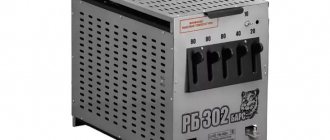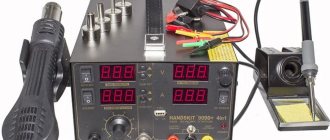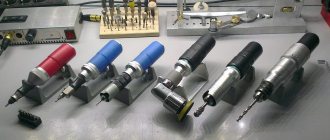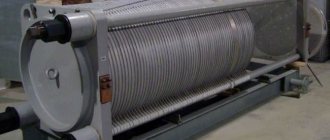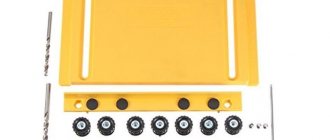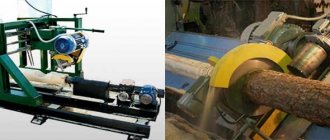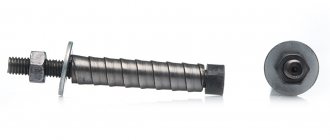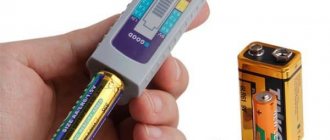One of the numerous physical and chemical processes that have found wide application, both in industry and in everyday life, is electrolysis - the release of their components (pure metal - aluminum, copper, gas and etc.). The main installation within which this process takes place is the electrolyzer.
Electrolyzer
What is an electrolyzer
An electrolyzer is a special installation used to separate its components from a solution or melt.
The main characteristics of the electrolyzer are:
- The operating voltage for one electrode ranges from 1.8 to 2.0 V;
- Current strength - for the normal course of the electrolysis process, a current with a value of this characteristic from 5 to 10 A is supplied to the electrodes;
- Number of electrodes – the minimum number of electrodes is 2, the maximum is limited by the size of the installation itself and its purpose;
- Dimensions of electrodes - not carbon rods are used as electrodes, but metal plates, the size of which is determined by the purpose of the installation, the current-voltage characteristic of the current supplied to the plates;
- Distance between differently charged electrode surfaces – the minimum distance between electrode plates must be at least 1.5 mm;
- Electrode material - in modern electrolysers, stainless steel sheets with the addition of nickel are used as the material for the anode and cathode.
Also another important characteristic of an electrolysis plant is the use of catalysts.
Such settings are used for the following purposes:
- Production of detonating gas consisting of a mixture of hydrogen and oxygen (Brown's gas);
- Isolation of pure aluminum, magnesium, zinc from molten salts;
- Purification of water from dissolved salts and impurities;
- Applying a thin corrosion-preventing layer of nickel and zinc to the surface of metal parts;
- Disinfection of food products;
- Purification of wastewater from heavy metal salts and other harmful substances dissolved in them.
Important! Platinum electrode made from ordinary iron is used in electrolysis installations less often than from stainless steel, since it oxidizes faster and becomes unusable.
Brief theoretical part
Hydrogen, also known as hydrogen, the first element of the periodic table, is the lightest gaseous substance with high chemical activity. During oxidation (that is, combustion), it releases a huge amount of heat, forming ordinary water. Let us characterize the properties of the element, formatting them in the form of theses:
- The combustion of hydrogen is an environmentally friendly process; no harmful substances are released.
- Due to chemical activity, the gas does not occur in free form on Earth. But its reserves in water are inexhaustible.
- The element is extracted in industrial production by a chemical method, for example, in the process of gasification (pyrolysis) of coal. Often a by-product.
- Another way to produce hydrogen gas is by electrolysis of water in the presence of catalysts - platinum and other expensive alloys.
- A simple mixture of hydrogen + oxygen gases explodes from the slightest spark, instantly releasing a large amount of energy.
For reference. Scientists who first separated the water molecule into hydrogen and oxygen called the mixture an explosive gas due to its tendency to explode. Subsequently, it received the name Brown's gas (after the name of the inventor) and began to be designated by the hypothetical formula NHO.
Previously, airship cylinders were filled with hydrogen, which often exploded
From the above, the following conclusion suggests itself: 2 hydrogen atoms easily combine with 1 oxygen atom, but they part very reluctantly. The chemical oxidation reaction proceeds with the direct release of thermal energy in accordance with the formula:
2H2 + O2 → 2H2O + Q (energy)
Here lies an important point that will be useful to us in further debriefing: hydrogen reacts spontaneously from combustion, and heat is released directly. To split a water molecule, energy will have to be expended:
2H2O → 2H2 + O2 – Q
This is the formula for an electrolytic reaction that characterizes the process of splitting water by supplying electricity. How to implement this in practice and make a hydrogen generator with your own hands, we will consider further.
Design and principle of operation
Electrolysis
The simplest electrolysis installation consists of several “cells”, each of which includes:
- 2 plate electrodes – cathode (negative) and anode (positive);
- A rubber gasket located around the perimeter of two adjacent opposite electrodes.
The outermost cells are equipped with special pipes through which the released gases are removed.
Several interconnected “cells” of an electrolysis plant
The electrolyzer can contain from 1 to 30-40 or more such “cells”, the plates of the same name are connected in series.
Important! When using AC power supplies, rectifiers are additionally used, the simplest of which is a diode bridge.
This installation works as follows::
- Distilled water with alkali or ordinary baking soda dissolved in it is poured into the space between the electrodes;
- From the power source, a voltage of 1.8-2.0 V is supplied to the electrodes of all cells of the installation;
- As a result of the electrolysis process, anions (positively charged ions) of a substance dissolved in water are attracted to the negatively charged cathode, as a result of which a thin film of sodium is formed on it;
- At the positively charged anode, water molecules are destroyed, each producing 2 hydrogen atoms and 1 oxygen atom;
- The released detonating gas flows through the outlet pipes into the container intended for it.
The intensity of the electrolysis process depends on the voltage and current - at low values of these characteristics the process will not proceed. If the power source supplies current with too high values of the current-voltage characteristic, the solution poured into the electrolyzer will heat up greatly and boil away.
Creation of a prototype
So that you understand what you are dealing with, first we suggest assembling a simple generator for producing hydrogen at minimal cost. The design of a homemade installation is shown in the diagram.
What does a primitive electrolyzer consist of:
- reactor - a glass or plastic container with thick walls;
- metal electrodes immersed in a reactor with water and connected to a power source;
- the second tank plays the role of a water seal;
- tubes for removing HHO gas.
Important point. The electrolytic hydrogen plant operates on direct current only. Therefore, use an AC adapter, car charger or battery as a power source. An AC generator will not work.
The operating principle of the electrolyzer is as follows:
- Voltage is applied to two electrodes immersed in water, preferably from a regulated source. To improve the reaction, a little alkali or acid is added to the container (ordinary salt at home).
- As a result of the electrolysis reaction, hydrogen will be released from the cathode connected to the negative terminal, and oxygen will be released near the anode.
- Mixing, both gases enter the water seal through the tube, which performs 2 functions: separating water vapor and preventing a flash in the reactor.
- From the second container, the detonating gas NHO is supplied to the burner, where it is burned to form water.
To make the generator design shown in the diagram with your own hands, you will need 2 glass bottles with wide necks and caps, a medical dropper and 2 dozen self-tapping screws. The full set of materials is shown in the photo.
Special tools will require a glue gun to seal plastic lids. The manufacturing procedure is simple:
- Twist flat wooden sticks with self-tapping screws, placing their ends in different directions. Solder the screw heads together and connect the wires - you will get future electrodes.
- Make a hole in the lid, insert the cut dropper body and wires into it, then seal it on both sides with a glue gun.
- Place the electrodes in the bottle and screw on the cap.
- Drill 2 holes in the second lid, insert dropper tubes and screw onto a bottle filled with plain water.
To start the hydrogen generator, pour salted water into the reactor and turn on the power source. The beginning of the reaction will be marked by the appearance of gas bubbles in both containers. Adjust the voltage to the optimum value and ignite the Brown gas coming out of the dropper needle.
Second important point. It is impossible to apply too high a voltage - the electrolyte, heated to 65 ° C or more, will begin to evaporate rapidly. Due to the large amount of water vapor, it will not be possible to light the burner. For details on assembling and launching an improvised hydrogen generator, watch the video:
Types of electrolyzers
Cathode and anode
Depending on the design and operating principle, there are 5 types of electrolysis plants.
Dry
Such electrolysers consist of plate electrodes separated from each other by sealed rubber gaskets. Often the “cells” of the installation are additionally placed in a sealed housing.
The hydrogen and oxygen produced as a result of electrolysis are discharged through special pipes located at the end of the housing or the outer plates of the installation.
Flow-through
Electrolysis plants of this type have the following structure:
- An electrolysis bath (housing) with two pipes, through one of which electrolyte is supplied into it, through the second, the detonating gas formed as a result of electrolysis is removed;
- Plate electrodes separated by spacers;
- A tank with electrolyte located above the housing with electrodes and connected by hoses to the branch pipes of the electrolysis bath of the installation and having a branch pipe with a gas valve in the upper part.
When such a device operates, the released gas enters the electrolyte tank through the pipe and hose and, creating a certain pressure in it, exits the installation through the valve on the outlet pipe.
Membrane
The electrolysis cells of such installations consist of two electrodes separated from each other by a thin membrane that allows the products of electrolysis to pass through and separates the electrodes from each other.
Membrane electrolysis plant
Diaphragm
Electrolysis installations of this type consist of a “U” shaped flask with two electrodes inserted into it and 2-3 impenetrable diaphragms. Similar electrolyzers are used to separately produce pure hydrogen and oxygen.
Alkaline
Unlike other models of electrolyzers, these use an alkali solution as an electrolyte - caustic soda (sodium hydroxide), which is not only an additional source of hydrogen and oxygen, but also a catalyst for electrolysis.
Alkaline electrolyzer circuit
Such installations, unlike analogues of other types, allow the use of cheaper electrodes made of ordinary iron.
About the Meyer hydrogen cell
If you have made and tested the design described above, then you probably noticed from the burning of the flame at the end of the needle that the performance of the installation is extremely low. To get more detonating gas, you need to make a more serious device, called the Stanley Meyer cell in honor of the inventor.
The principle of operation of the cell is also based on electrolysis, only the anode and cathode are made in the form of tubes inserted into one another. Voltage is supplied from the pulse generator through two resonant coils, which reduces current consumption and increases the productivity of the hydrogen generator. The electronic circuit of the device is shown in the figure:
Note. The operation of the circuit is described in detail on the resource https://www.meanders.ru/meiers8.shtml.
To make a Meyer cell you will need:
- a cylindrical body made of plastic or plexiglass; craftsmen often use a water filter with a lid and pipes;
- stainless steel tubes with a diameter of 15 and 20 mm, a length of 97 mm;
- wires, insulators.
Stainless steel tubes are attached to a dielectric base, and wires connected to the generator are soldered to them. The cell consists of 9 or 11 tubes placed in a plastic or plexiglass case, as shown in the photo.
Electrolyzer for hydrogen production
Grounding calculation
In order to assemble a simple electrolyzer with your own hands, you can use the drawing shown in the figure.
Drawing of a simple homemade electrolyzer
Note! An electrolyzer is a rather dangerous installation; the detonating gas released during operation, accumulating in large quantities, can cause a serious explosion. The installation should not be placed near sources of open fire or heating devices.
DIY electrolyzer for a car
To improve fuel combustion in a car engine, an electrolyzer is often assembled, consisting of a housing from an old battery with stainless steel plates placed inside, two pipes, one of which is connected to a tank filled with electrolyte, the second to a hose supplying air to the engine (more precisely, with a corrugated pipe going from the air intake to the air filter).
Such a homemade flow electrolyzer is powered from a car battery using a relay and a 10 A fuse.
Plate reactor
A high-performance hydrogen generator capable of ensuring the operation of a gas burner is made of stainless steel plates measuring 15 x 10 cm, quantity - from 30 to 70 pieces. Holes are drilled in them for the tightening pins, and a terminal for connecting the wire is cut out in the corner.
In addition to sheet stainless steel grade 316, you will need to buy:
- rubber 4 mm thick, resistant to alkali;
- end plates made of plexiglass or PCB;
- tie rods M10—14;
- check valve for gas welding machine;
- water filter for water seal;
- connecting pipes made of corrugated stainless steel;
- potassium hydroxide in powder form.
The plates must be assembled into a single block, isolated from each other with rubber gaskets with a cut out middle, as shown in the drawing. Tie the resulting reactor tightly with pins and connect it to the pipes with the electrolyte. The latter comes from a separate container equipped with a lid and shut-off valves.
Note. We tell you how to make a flow-through (dry) type electrolyzer. It is easier to manufacture a reactor with submersible plates - there is no need to install rubber gaskets, and the assembled unit is lowered into a sealed container with electrolyte.
The subsequent assembly of the generator producing hydrogen is carried out according to the same scheme, but with differences:
- A reservoir for preparing electrolyte is attached to the body of the device. The latter is a 7-15% solution of potassium hydroxide in water.
- Instead of water, a so-called deoxidizing agent is poured into the “bubbler” - acetone or an inorganic solvent.
- A check valve must be installed in front of the burner, otherwise when the hydrogen burner is turned off smoothly, the backlash will rupture the hoses and the bubbler.
To power the reactor, the easiest way is to use a welding inverter; there is no need to assemble electronic circuits. How a homemade Brown gas generator works is explained by a home craftsman in his video:
Overview of electrolyzer manufacturers
The main manufacturers of electrolyzers are both domestic enterprises (RUSAL, NPF RutTech, JSC Uralkhimmash), as well as their foreign competitors - Teledyne Energy Systems, Inc (USA), Hydrogenics Corp. (Belgium).
Thus, the electrolyzer is a fairly simple installation with a wide range of functions, used to produce detonating gas, which in the future is planned to be used as fuel for internal combustion engines and heating boilers.
